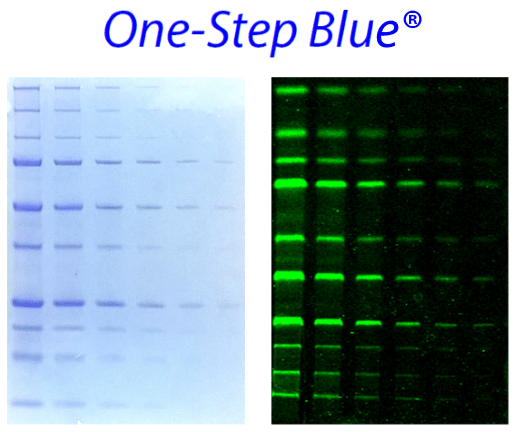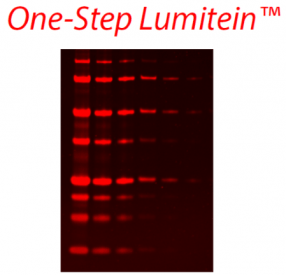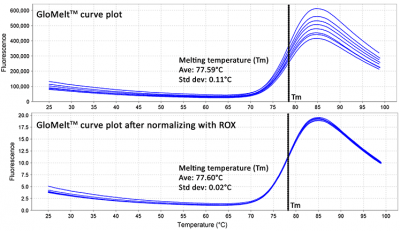One-Step Blue® & One-Step Lumitein™ Protein Gel Stains
Our One-Step protein gel stains are low-cost, quick, and easy-to-use. Simply add stain to your SDS-PAGE gel without fixing or washing, and stain for 5 to 60 min. These stains are non-toxic for safer handling, and are certified under CCR Title 22 as non-hazardous for drain disposal after pH neutralization. One-Step Blue® replaces Coomassie® for visible staining or near-IR fluorescence. One-Step™ Lumitein replaces SYPRO® Ruby for UV box or gel scanner, and One-Step™ Lumitein UV replaces Oriole™ for UV transilluminator.
One-Step Stains Features
- Fast, simple staining
- No fixing, microwaving, or washing
- Aqueous-based and non-toxic for drain disposal
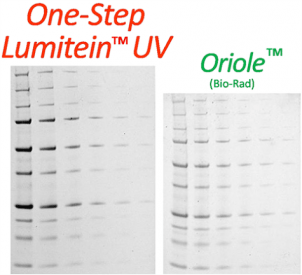
Product Information
| Product | Replacement for | Catalog number | Unit size | Product protocol | Safety report |
|---|---|---|---|---|---|
|
One-Step Blue® |
Coomassie Brilliant Blue stains | 21003-1L | 1L |
PI-21003 |
One-Step Gel Stains Safety Report |
| One-Step Lumitein™ | SYPRO® Ruby Protein Gel Stain | 21004-1L | 1L | PI-21004 | |
| 21004-4L | 4L | ||||
| One-Step Lumitein™ UV | Oriole™ and Flamingo™ Protein Gel Stains | 21005-1L | 1L | PI-21005 | |
| 21005-4L | 4L |
Lumitein and its related technologies are covered by US and international patents. SYPRO is a registered trademark of Molecular Probes, Inc. Oriole is a trademark of Bio-Rad Laboratories. Coomassie is a registered trademark of Imperial Chemical Industries.
VersaBlot™ Total Protein Normalization Kits
VersaBlot™ Total Protein Normalization Kits allow simple, sensitive and highly linear protein quantitation on SDS-PAGE gels and western blot membranes. The kits allow you to label purified proteins or cell lysates with our near-infrared CF® dyes before running the samples on SDS-PAGE. Proteins can then be visualized on a gel or membrane using a fluorescent gel scanner, allowing detection of as little as 1 ng protein per band. If desired, the prestain can be reversed after scanning, facilitating downstream multi-color western blot analysis. The staining demonstrates excellent linearity for quantitation of total protein over a wide dynamic range, outperforming traditional western blot normalization based on housekeeping protein detection.
VersaBlot™ Total Protein Prestain Features
- Reversible prestain for downstream multi-color western blot analysis
- Superior linearity for western normalization compared to housekeeping proteins
- Highly sensitive protein quantitation on PAGE gels or western membranes
- Fast and simple labeling of proteins or lysates, no purification required
- Detect as little as 1 ng protein and 10% difference in protein content
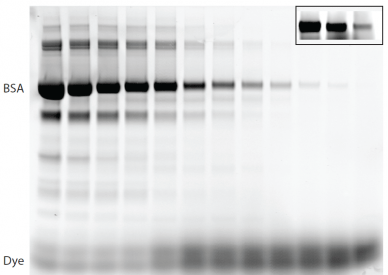
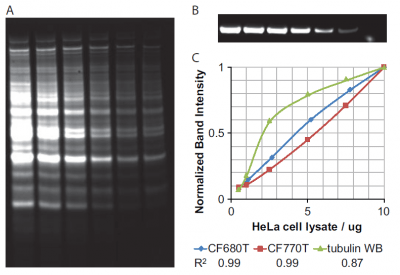
VersaBlot™ Total Protein Normalization Kits
| Product | Catalog number | Size | Abs/Em | Imaging Systems / Detection channels |
|---|---|---|---|---|
|
VersaBlot™ CF®680T Total Protein Normalization Kit |
33025-T | 100 labelings | 681 / 698 nm | Amersham Typhoon™ Trio Cy®5 channel Amersham Typhoon™ 5 IR short channel LI-COR® Odyssey® 700 channel |
| 33025 | 500 labelings | |||
| VersaBlot™ CF®770T Total Protein Normalization Kit | 33026-T | 100 labelings | 764 / 787 nm | Amersham Typhoon™ 5 IR long channel LI-COR® Odyssey® 800 channel |
| 33026 | 500 labelings |
GloMelt™ 2.0 Protein Thermal Stability Assay
Thermal shift assay for protein stability
The thermal shift assay, also called Protein Thermal Shift™, differential scanning fluorimetry, or Thermofluor assay, is a simple technique for measuring protein denaturation temperature. The assay is a rapid and inexpensive technique that can be used to screen conditions that affect protein thermal stability, such as protein mutations, ligand binding, and buffer formulations (like pH, salts, detergents, and other additives). The assay can be performed on a conventional quantitative PCR system and is compatible with high-throughput screening, requiring much less protein than methods like circular dichroism and differential scanning calorimetry.
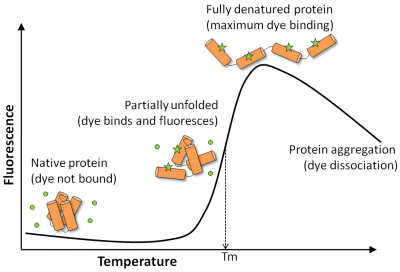
GloMelt™ Dye for protein thermal stability
GloMelt™ Dye undergoes fluorescence enhancement upon binding to hydrophobic regions of denatured proteins, and can be used to detect protein unfolding in thermal shift assay. GloMelt™ Dye is optimized for detection in the SYBR® Green channel, so it generates much stronger signal than SYPRO® Orange and PROTEOSTAT® TS dyes, which have spectra that are not well-matched to common qPCR fluorescence channels. Because GloMelt™ has green fluorescence, it also can be used with ROX normalization for improved replicate consistency.
GloMelt™ tolerates a wide variety of common stabilizers and destabilizers, and unlike SYPRO® Orange, it performs well in the presence of detergents. SYPRO® Orange and PROTEOSTAT® TS dyes are highly hydrophobic, so after dilution in buffer the dyes must be used immediately. In contrast, GloMelt™ has excellent water solubility, allowing storage of diluted dye solutions for greater convenience and less wasted dye.
The GloMelt™ 2.0 Thermal Shift Protein Stability Kit features Recombinant Monoclonal Mouse IgG1 for performing control reactions. Compared to the polyclonal goat IgG control provided in our original GloMelt™ kit, this recombinant mouse antibody generates higher signal and a sharper melt peak between for robust assay validation.
GloMelt™ 2.0 Applications
- A high-throughput method for sample screening via protein thermal stability
- Screen molecules (e.g. drug candidates, antibodies) for ligand binding
- Identify protein stability changes from point mutations or other modifications
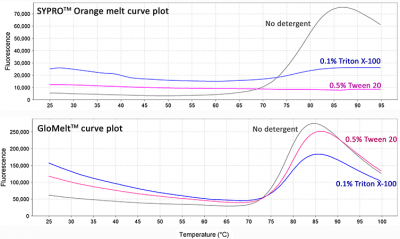
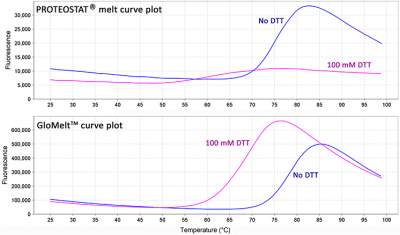
Product Information
| Product | Kit contents | Catalog number | Size* |
|---|---|---|---|
| GloMelt™ 2.0 Kit | • GloMelt™ Dye • Recombinant Mouse IgG1 Control |
33027-T | 200 assays |
| 33027-1 | 2000 assays | ||
| GloMelt™ 2.0 Kit with ROX | • GloMelt™ Dye • Recombinant Mouse IgG1 Control • ROX Reference Dye |
33028-T | 200 assays |
| 33028-1 | 2000 assays | ||
| GloMelt™ Kit | • GloMelt™ Dye • Goat IgG Control |
33021-T | 200 assays |
| 33021-1 | 2000 assays | ||
| GloMelt™ Kit with ROX | • GloMelt™ Dye • Goat IgG Control • ROX Reference Dye |
33022-T | 200 assays |
| 33022-1 | 2000 assays | ||
| * Size based on 20 uL reaction volume | |||
SYPRO is a registered trademark of Thermo Fisher Scientific; Protein Thermal Shift and QuantStudio are trademarks of Thermo Fisher Scientific; PROTEOSTAT is a registered trademark of Enzo Life Sciences.
AccuOrange™ Fluorescent Protein Quantitation Assay
AccuOrange™ Protein Quantitation Kit is a highly sensitive fluorescence-based assay for quantitating purified protein or antibody samples in 96-well format. The detection range of the assay is 0.1-15 ug/mL protein. AccuOrange™ is much more sensitive than traditional protein quantitation assays such as BCA, Bradford and Lowry, and is more linearity and reproducible compared to the NanoOrange® protein quantitation assay. The assay shows minimal variability between different proteins, and has stable fluorescence signal for up to 16 hours. The AccuOrange™ assay has low tolerance for detergents, and is not recommended for use with cell lysates.
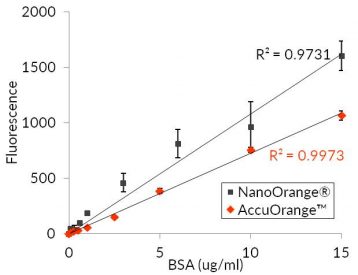
| Assay | Detection Range | Comments |
|---|---|---|
| AccuOrange™ | 0.1-15 ug/mL | Fluorescence-based (480/598 nm) Highly linear Signal stable for at least 16 hours Compatible with reducing agents Not compatible with detergents |
| NanoOrange® | 0.1-10 ug/mL | Fluorescence-based (470/570 nm) Non-linear Fluorescence stable for 6 hours Compatible with reducing agents Not compatible with detergents |
| Modified Lowry | 1-1500 ug/mL | Absorbance-based (750 nm) Non-linear Not compatible with reducing agents or detergents |
| BCA | 20-2000 ug/mL | Absorbance-based (562 nm) Highly linear Signal not stable over time Not compatible with reducing agents Compatible with detergents |
| Bradford (Coomassie®) | 50-500 ug/mL | Absorbance-based (595 nm) Signal not stable over time Non-linear Compatible with reducing agents Not compatible with detergents |
| Pierce® 660 nm | 50-2000 ug/mL | Absorbance-based (660 nm) Non-linear Compatible with reducing agents & detergents |
| A280 | 50-2000 ug/mL | Absorbance-based (280 nm) High protein-protein variability Contaminants and detergents can affect results |
Product Information
| Product | Catalog number | Size | Features |
|---|---|---|---|
| AccuOrange™ Protein Quantitation Kit | 30071-T | 200 assays | • Highly sensitive: detect 0.1-15 ug/mL protein • Excellent linearity and low variability • Stable fluorescence signal • Compatible with reducing agents and other additives • For use with purified protein or antibody samples |
| 30071 | 1000 assays |
NanoOrange is a registered trademark and Pierce is a trademark of Thermo Fisher Scientific; Coomassie is a registered trademark of Imperial Chemical Industries.
Conjugates and accessories for western blotting
Near-infrared (near-IR) western detection is highly sensitive, and offers advantages of wider linear range and multiplexing capability compared to chemiluminescence detection (see our webinar to learn more). Biotium’s near-IR CF® dyes are the brightest and most photostable available. Learn more about CF®680 and CF®770 dyes for near-IR western, In Cell Western®, and other applications.
We offer wide selection of primary and secondary antibodies conjugated to our exceptional near-IR CF® dyes for western blot, as well as HRP conjugates for chemiluminescence detection. Also see below for our selection of protein markers, buffers, blocking agents, and more for western blotting.
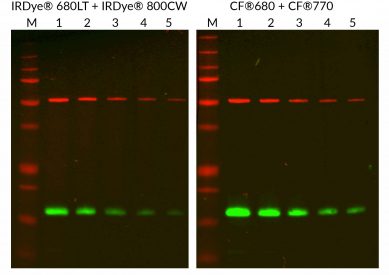
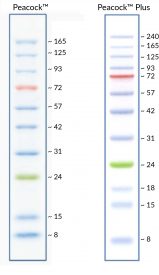
Product Information
| Product | Catalog No. | Size | Features |
|---|---|---|---|
| Peacock™ Prestained Protein Marker | 21530 | 50 uL or 500 uL | • Visible color protein marker for SDS-PAGE and western • 8 blue bands ranging from 10 kDa to 180 kDa • Red/green bands at 75 kDa/25 kDa |
| Peacock™ Plus Prestained Protein Marker | 21531 | 50 uL or 500 uL | • Visible color protein marker for SDS-PAGE and western • 10 blue bands ranging from 8 kDa to 245 kDa • Red/green bands at 75 kDa/25 kDa |
| 4X Protein Loading Buffer with Orange Tracking Dye | 40136 | 15 mL | • A convenient 4X sample loading buffer for protein gel electrophoresis • Optimized for use with denaturing SDS-PAGE • Orange tracking dye avoids unwanted background fluorescence caused by blue tracking dyes |
| Ponceau S Solution | 22001 | 1 L | • Stain proteins on PVDF or nitrocellulose membranes with visible pink dye • Fast & reversible visualization of protein transfer before western detection |
| TrueBlack® WB Blocking Buffer Kit | 23013 | For 10 membranes or 50 membranes | • Superior blocking for fluorescent WB • Works as well or better than Odyssey® Blocking Buffer, at a lower cost • Suppresses background caused by charged fluorescent dyes • Reduces antibody cross-reactivity, eliminating non-specific bands |
| 10X Fish Gelatin Blocking Agent | 22010 | 100 mL | • Provides excellent blocking for IF or western • Add to buffer of your choice (PBS or TBS) • Compatible with anti-goat and anti-sheep secondaries |
| Fish Gelatin Powder | 22011 | 2 x 50 g | • Gelatin from cold water fish skin for blocking for IF or western • Compatible with anti-goat and anti-sheep secondaries |
| Bovine Serum Albumin, 30% Solution | 22014 | 100 mL | • Commonly used blocking agent and antibody or protein stabilizer • 30% solution in water • Made from IgG-free, protease-free Fraction V BSA |
| Bovine Serum Albumin Fraction V | 22013 | 50 g | • Commonly used blocking agent and antibody or protein stabilizer • IgG-free, protease-free Fraction V BSA |
| Dry Milk Powder | 22012 | 4 x 25 g | • Nonfat dry milk • Commonly used blocking agent for western |
| Tween®-20 | 22002 | 50 mL | • Detergent commonly used for western blocking and washing |
| Mini Cell Scrapers | 22003 | Pack of 200 | • For harvesting cells or cell lysates from 96-, 48- and 24-well plates • 0.5 cm (3/16″) wide and 6 cm (2 3/8″) long • 20 packs of 10 scrapers per pack • Polyethylene, disposable & sterile |
| Ultrafiltration Vials (3K MWCO) | 22018 | Pack of 5 | • For removing buffers, salts, and free dyes from proteins or DNA • Simple microcentrifuge spin-column format • 3 kDa molecular weight cut-off (MWCO) |
| Ultrafiltration Vials (10K MWCO) | 22004 | Pack of 5 | • For removing buffers, salts, and free dyes from proteins or DNA • Simple microcentrifuge spin-column format • 10 kDa molecular weight cut-off (MWCO) |
| DTT | 91050 | 1 g | • Reducing agent commonly used to prepare samples for SDS-PAGE |
| TCEP | 91049 | 1 g | • Odorless reducing agent • More effective and stable than DTT |
LI-COR, Odyssey, IRDye, and In Cell Western are registered trademarks of LI-COR Biosciences.
Associated products
One-Step Blue® Protein Gel Stain
One-Step Lumitein™ Protein Gel Stain
21004-1L, - 21004-4LView allHide
One-Step Lumitein™ UV Protein Gel Stain
21005-1L, - 21005-4LView allHide
Peacock™ Prestained Protein Marker
21530-50uL, - 21530-500uLView allHide
Peacock™ Plus Prestained Protein Marker
21531-500uL, - 21531-50uLView allHide
AccuOrange™ Protein Quantitation Kit
30071, - 30071-TView allHide
GloMelt™ Thermal Shift Protein Stability Kit
33021-T, 33022-T, 33021-1, - 33022-1View allHide
VersaBlot™ Total Protein Normalization Kits
33025-T, 33025, 33026-T, - 33026View allHide

